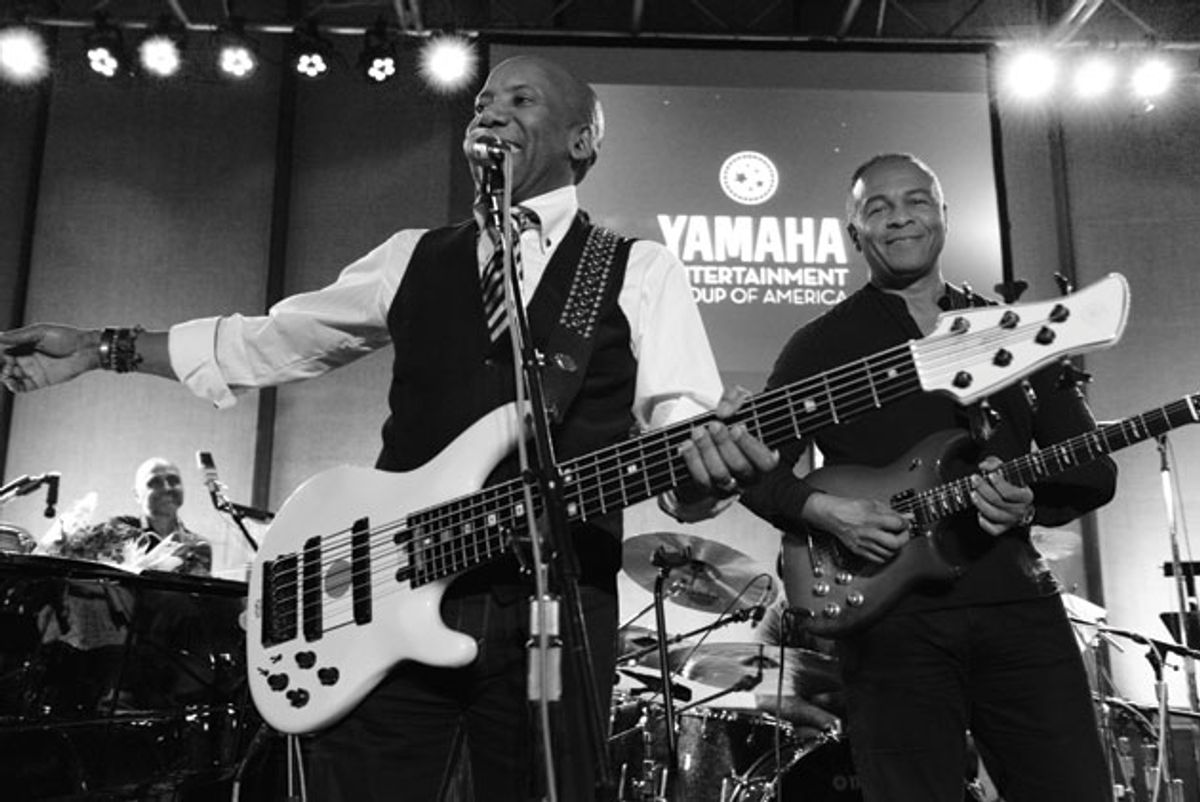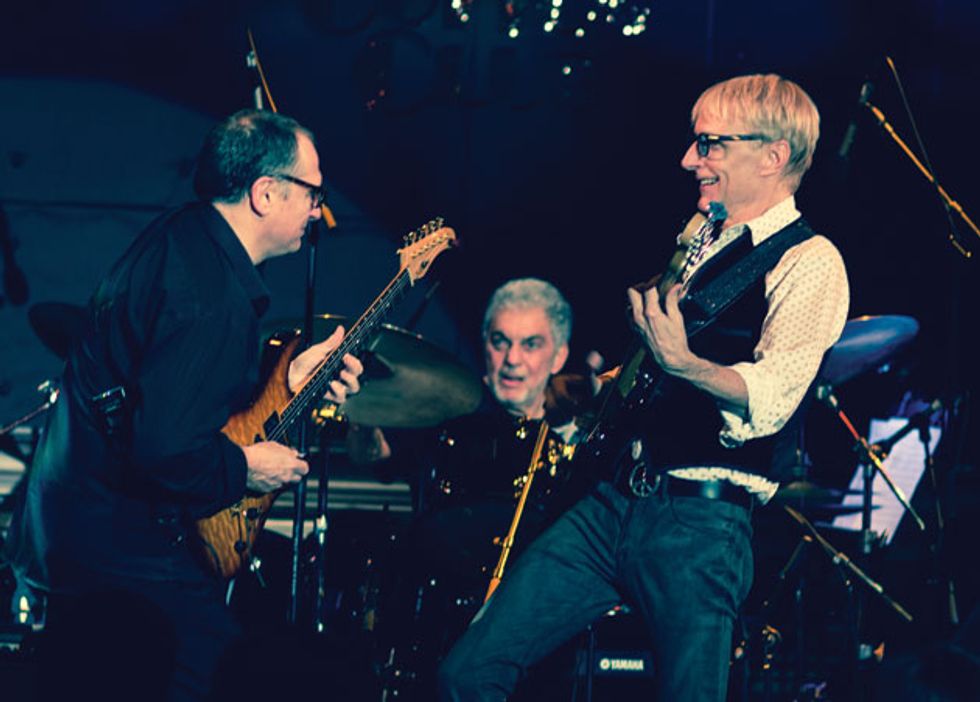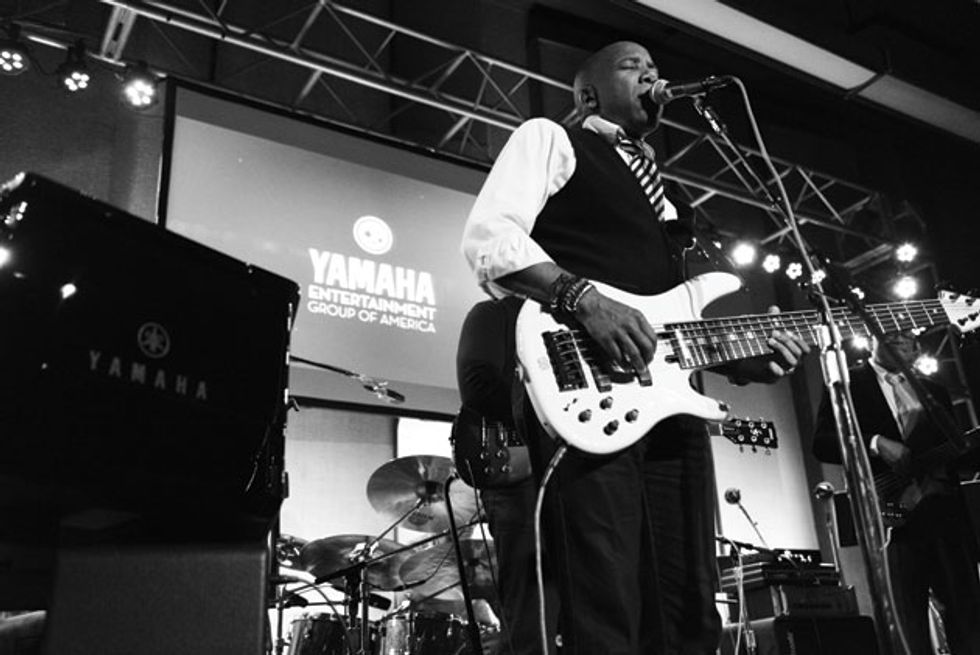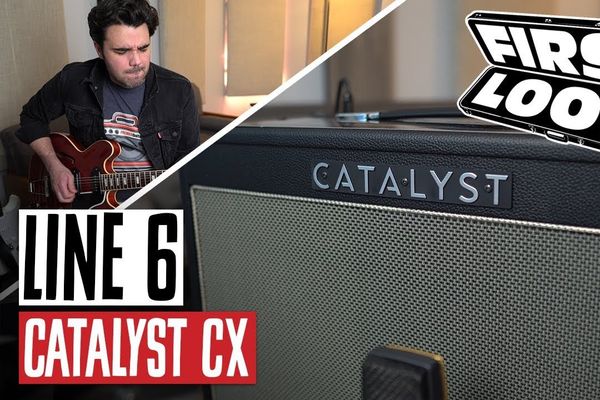Will interviews Nathan. Nathan interviews Will. It’s a super-bass summit!
Though they rarely share the same stage, bassists Nathan East and Will Lee have had strikingly similar musical journeys. Both came up through the then-bountiful studio scene (East in L.A. and Lee in New York) and became first-call sideman on their respective coasts. During that time both bassists developed a reputation for substance over flash while praying at the altar of Larry Graham and Chuck Rainey. Since 1982 Lee has held down the bass chair on David Letterman’s late night show while doing sessions, serving in the house band for the Rock ’n’ Roll Hall of Fame inductions, and issuing several solo albums. East is more of a road dog: For many years he served with Eric Clapton while recording and performing with everyone from Sting and Stevie Wonder to Phil Collins and Toto.
Both bassists recently added important new entries to their extensive discographies. Lee’s solo album Love, Gratitude & Other Distractions embraces everything from dirty NOLA blues with the Reverend Billy Gibbons to heartfelt jazz standards. For East, it was time to step outside of his longtime group Fourplay for his first-ever solo release, which boasts Stevie Wonder tunes, (with the man himself), orchestral textures, and a touching duet on the Beatles “Yesterday” with Nathan’s son Noah.
We decided to let the two bass greats interview each other about their respective projects. Naturally, they couldn’t resist talking shop, swapping stories, and paying tribute to some of their heroes. Let’s listen.
Lee: Well, it’s an honor to be considered in the same sentence as Nathan East.
East: Come on, man! You’re stealing my line! [Laughs]. I was thinking earlier today about the first time we met. When was that?
Lee: One of the first times I actually remember meeting you—and I’m sure it happened before then, because I have a history of being a drug addict and alcoholic, so there are parts of my life that aren’t clear—was at Live Aid.
East: Oh, wow. Yeah, that was ’85.
it’s a big hit.”—Nathan East
Lee: I’m sure we must have meet before then. That was the year I got sober. You were there with Kenny Loggins, and you were just as nice then as you always are.
East: I’d heard of you as far back as ’82. There was a session that [guitarist] Chuck Loeb and I met at for a Patrick Williams record at Clinton Studios. You were probably the only cat who wasn’t there—it was Steve Gadd, both Breckers. And I was like, “Why am I here?” because you were right down the street. [Laughs]. You must have been busy.
Lee: As you know, there was a time when sessions were rampant. And in New York, because of the proximity of everything, it was easy to do five or eight sessions a day. There was a lot of running around. There were times I’d head to a vocal session and leave my bass in the trunk of a cab because I’d be so frazzled. We should have had multiple basses and just left them at studios. But we weren’t thinking about that. We had our favorite bass, and that was the one we wanted to have with us.
East: What was your favorite bass during that era?
Lee: I bought a bass from Tom “Bones” Malone. It was a Fender Precision, and I didn’t realize how amazing it was until it burned up in a fire in 1975. I’ve been trying to replace it ever since. It had such a great range of sound that I ended up playing a Jazz bass on an emergency basis after trying out so many other P basses. That bass had all the harmonics. It had presence. It didn’t have that hollow Precision sound. It had a really nice, meaty sound.
East: I was a Jazz bass guy at the time, too. Then I had a cool Precision that just had that P sound. Then I jumped on the Yamaha train. Abraham Laboriel put the first Yamaha bass in my hands, and I was like, “What is that?” Of course, it’s the fingers, not the bass, but he just had the thing smoking. Thirty-some years later I’m still playing Yamahas.
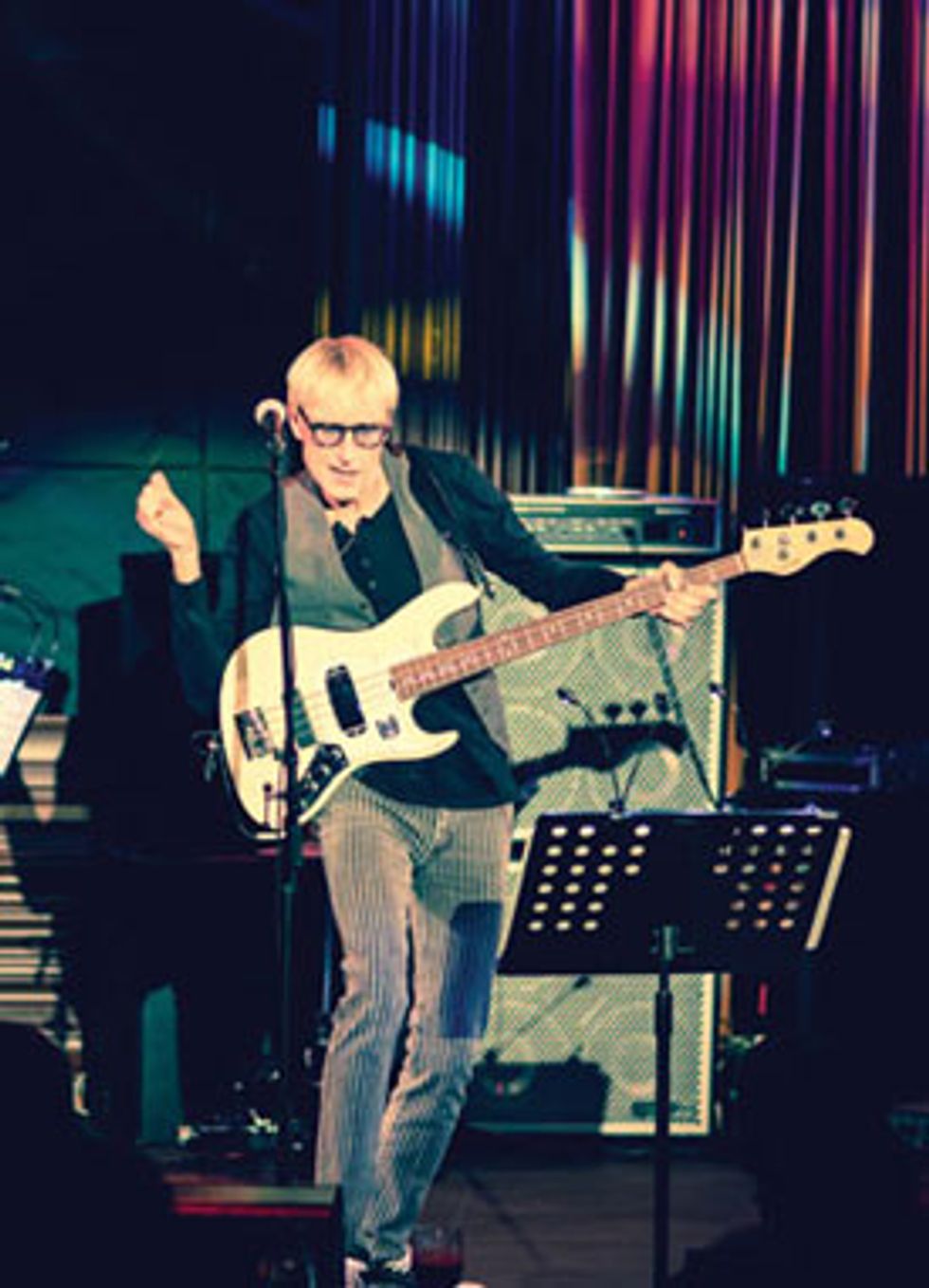
Will Lee drops a low G with his thumb during a show in Japan. Photo by Sandrine Lee
Lee: It’s still pretty much a glorified Jazz bass, really.
East: Exactly! I just told someone that yesterday.
Lee: My question is: If Nathan’s first album is this good, how scary is the second one going to be?
East: I’ve been talking about this for a long time: literally more than two decades. Bob James and the guys in Fourplay give me such a hard time about it. I used to start making demos for a solo record, but then we’d go into making a Fourplay record, and I wouldn’t be prepared for that, so my tune would just go over there. Chuck Loeb pulled me aside in Montreux a couple of years ago and said, “Nate, what’s the holdup? You aren’t getting any younger. Let’s do this!” So we made a list of all the people it would be fun to include.
Lee: What was the holdup? Was there any sense of not wanting to commit to a direction?
East: Even when you make a plan, it comes out completely differently, so why even plan? But number one, Fourplay has been my solo spot because I get to write, blow, and pretty much do whatever I want. That’s taken a bit of the pressure off. The other thing is just being blessed with a ton of work. If you’re not on a Clapton or Phil Collins tour, or out with Herbie Hancock or Al Jarreau, you’re in the studio. I didn’t want it to be a weekend thing where I would go in and do two more tracks. I wanted to have some cohesiveness, and I’m glad I got a rhythm section for an entire week.
Lee: That’s pretty organized, man.
East: How did you plan the sessions for your album?
Lee: I was starting to explode with ideas to the point when I just had to get them out. I started with one song, and then I recorded a second song that had nothing to do the first one. I said, “Well, this looks like the makings of a non-album!” But I’m realizing that the content of my record is, so to speak, shit I like. So that’s what I went for. I didn’t care about a direction. I just wanted to have a great time and make each tune its own little journey.
Playing his signature Sadwosky 4-string, Lee digs in during one of his Will Lee Family Band shows with guitarist Chuck Loeb. Photo by Sandrine Lee
East: It really worked out. What was that first song that came together?
Lee: I put together an autobiographical song called “Miss Understanding.” The tune kind of wrote itself because it was just so honest from my life. I was at one of those songwriter circles up at a church in Massachusetts, where people sit around with guitars and play their own tunes and back each other up. Someone gave us a recording of it. Then there’s this kindred spirit-type guy, a drummer who had been through the same scenario as the person in this song—with the same person! So I told him, “You got to hear this, because it’s your story too.” He liked it so much that he put a drum track to it, and it really held together. At that point you could see the potential for a completed song, so I just wiped all the tracks except the drums and recording new instruments onto his track. I thought, since we live in the age of iTunes, nobody cares about an album, and maybe I’ll just put this out. But there was this other song I wanted to record with Chuck Loeb, an instrumental version of “Smile.” That was the point when I realized that these songs have nothing whatsoever to do with each other. So maybe I should do an album. [Laughs].
East: I’m shedding “Smile” because of that recording.
Lee: It’s something I’ve been working on for a while. I was forced to finish it onstage in Japan, and you know what fertile ground for creativity that can be. I was with Hiram Bullock, the most fertile of fertile grounds, and he had some gear problem, so we had to stop the show. So I went up front and started to play this little bit of “Smile” that I had figured out on bass, and because I’m in the middle of it and Hiram’s not ready yet, I had to keep going. At that point I was forced to finish the arrangement right there onstage. I’ve been carrying that around for a while, and it took someone like Chuck Loeb—not like there’s anyone like him—to turn it into a real arrangement with his beautiful soundscape of colors.
East: That’s a great memory to have of Hiram.
and he’s been dead for a million years.”—Will Lee
Lee: Absolutely. Hiram’s with me every day, man. He taught me what to do onstage. There are certain people who are so strong—Jaco for example. Jaco is still kicking everyone’s ass, and he’s been dead for a million years.
East: He’s always on your shoulder, haunting you. Saying, “Take it up a couple of notches.”
Lee: Tell me how you picked the covers for your album.
East: It’s usually stuff you’ve been digging forever. I guess the funniest, or most recent story, happened when I was in Norway. There was an 18-piece big band playing for a wedding at my hotel, and when we got back from the gig I heard them playing “Sir Duke.” I just peeked my head in, and the bass player sees me and hands me his bass. The next thing I know, I’m playing with this band somewhere in Norway. I looked around and saw a room full of people I didn’t know. I’m 6,000 miles away from home, and everybody’s smiling. That tune is just infectious. But similarly to your story, I was in rehearsal at Carnegie Hall for one of Sting’s rainforest benefits. There’s some downtime, and I’m up there trying to figure out the chords to “Overjoyed,” when I hear a harmonica come in, and the next thing I know Stevie Wonder is actually playing it with me. Then James Taylor, Bonnie Raitt, Elton John, and George Harrison are all standing there watching the whole thing go down. Again, I was painted into a corner and had to come up with an arrangement on the spot. When we finished, he said, “If I ever record that, call me.” That’s how I got him on the album.
Lee: Tell me about “Daft Funk.”
Nathan East's Gear
Basses
Yamaha BBNE-2 Signature 5-string bass
Yamaha TRB 6-string bass
Yamaha SLB-200 Silent bass
Amps
TC Electronic Blacksmith
Effects
None
Strings and Accessories
Radial Engineering Firefly tube DI
Dunlop Strings
j-phonic earphones
Yamaha HPH-MT220 Headphones
Phil Jones Bass Headphones
East: It’s a tongue-in-cheek ode to the guys in Daft Punk. Daft Punk made it cool to play again. Here’s a record that went number one that didn’t just have a programmed sound. It’s only four chords, but it’s actual playing.
Lee: As a session guy, you never really know what’s going to hit.
East: I’ve played on records, and I’m sure you have too, where you think, “This is the greatest thing ever—wait until everyone hears it!” and it never does a thing. Then one day you go to work and play on something, not giving it a thought, and the next thing you know, it’s a big hit. But I had a feeling “Get Lucky” was going to be something because it was Nile Rodgers and Paul Jackson, Jr., on the same song. I don’t think there’s room for any more funk on a two-inch piece of tape. [Laughs].
Lee: That’s pretty scary!
East: That in and of itself was pretty monumental. I knew that was going to make some noise. We cut some live tracks in L.A., and then I think they took it to New York and put Nile on the songs, and then they came back, and we tweaked the bass to make it even funkier.
Lee: There was some room left? Like, “Here’s a space right there!”
YouTube It
Drummer Takanori Niida leads a funky quartet that features Will plus one of his longtime collborators, guitarist Oz Noy. Check out the finger-busting groove of "Confidence Cat" at 2:55.
East: How did you hook up with Billy Gibbons for “Get Out of My Life Woman?”
Lee: Billy is such a personable guy. I had my engineer coming over to work on something else for the album, and the phone rang and I heard, “It’s Gibbons. I’m in town.” The funny thing is that morning I woke up with that song in my head, and I was singing it to my wife. When the phone rang I was still thinking about the song and I said, “Billy, what are you doing tonight? You want to come over and sing this song?” He said, “I got a terrible cold. So we better record it before it goes away.” [Laughs]. I know a lot of divas, and I’m not used to singers saying those words. So I called up Shawn Pelton and asked him to put down a groove for us to play over. I sang him a quick beat and asked for a little loop. He says, “I’m going into a yoga class right now, but I’ll have it for you in two hours.” He not only remembered the tempo, but also the beat. I had to chop it up a little bit because I wrote this three-bar section at the end for cats to blow on, because I already had it in mind to ask Allen Toussaint to play on it. It worked out really nice. In fact, Shawn, being the great musician that he is, heard what we’d done and wanted to replace the drum track. He did a new track, but it wasn’t nearly as groovy as the first thing he did, so we kept the chopped-up version and stuck in a few new fills. When you’re following a drummer, he’s leading the groove, but when he’s following the groove, it just doesn’t have the same meat or impetus. He’s no long driving the bus.
East: Did you use an amp on your record or just a DI?
Lee: It depends on the session. I've never been a huge fan of using an amp in the studio. I almost didn’t really care what kind of amp was hanging around the studio. There’s a song called “Papounet’s Ride,” which is a chop-buster of a tune that I still can’t play yet. It’s like a handful of notes and harmonics—a little “bass invention” kind of thing. And in order to get those harmonics and the notes out in one pass, I had to find a way to bring out everything. I used a miniature version of an Ampeg SVT that I use in my studio for practicing and testing basses and stuff, because when you put all the knobs at noon it has a pretty honest sound.
East: I actually prefer just the direct sound and basically the shortest signal path. One cable to the DI. I have this great Radial Firefly DI, and it’s fantastic. The reason I got it is because it has two inputs, and you can adjust the volume for each, so I had the upright on one and the electric on the other. It’s a full tube DI, and I absolutely love the way it sounds. I had to go direct, and if it ain’t broke, let’s keep going. Normally, I choose not to use an amp just to get the sound right.
East: At one point I was really fiddly about DIs, and I always had to lug some big DI around. But it’s not the toys—it’s the noise.
Lee: There was an album by Donald Fagen a couple of years ago called Morph the Cat. The first thing you heard was Freddie Washington’s bass playing really out in the open, and it was just the most delicious bass sound. I said, “That’s the shit right there!” I asked Elliot Scheiner, the engineer on the record, “Man, can you tell me how you got that bass sound?” He just said, “Tape,” and then he kind of walked away. I said, “Aw, come back here!” But that’s all I could get out of him, and I think I know what he meant, you know? In his mind, that was the answer. So there’s still room for the digital world to catch up on certain aspects of what makes a good bass sound. Ever heard of a thing called Graham Central Station?
Will Lee's Gear
Basses and Guitars
Sadowsky Will Lee NYC 4-string
Sadowsky Will Lee NYC 5-string
1961 Fender Precision
1960s Fender Precision hybrid fretless
Pedulla fretless 5-string
Line 6 Variax Guitar
Amps
Ampeg Micro-VR
Effects
Boss GT-10B
Xotic Effects RC Booster
Various Electro-Harmonix pedals
Strings and Accessories
Sadowsky Black Label Strings
GHS Precision Flats
Charter Oak SA 538 Microphone (for vocals)
Empirical Labs Distressor
East: [Laughs]. That was the first one! My phone was blasting off the hook when that came out. I think Larry Graham and Jaco were the two guys that messed up bass players the most.
Lee: Quite possibly, yes. I was also fascinated by Chuck Rainey, and still am.
East: Me too.
Lee: Chuck Rainey, on a Precision bass, of course. Sometimes you have to add the drummer to the mix—especially if it’s Bernard Purdie. There was a thing that happened with him that I tried to emulate, and still do. It’s just a matter of your forefinger and middle finger. Either one, actually—he’s almost a one-finger guy. Rubbing across the string really lightly allows the bass to sing in a beautiful way. And when the finger comes back to get ready to play the next note, it stops the note that’s ringing and gives it a really cool percussive sound, almost like a stone bouncing across water. It’s just such a beautiful sound when it gets recorded on tape. I go through contortions trying to get that happening with my big two fingers pounding the hell out of the bass. I think I do a good impression, but it takes me a lot more work to get there. He was effortless. Pure genius.
East: It’s amazing.
Lee: Man, there are so many great bass tones. I just love when you can hear the wood. It’s funny—with basses it’s all about that piece of wood and that electronic circuit.
East: And the spirit of the guy who’s holding it! For years you go into a studio and just plug into whatever they have, and it still sounds like you.
Lee: It still sounds like a bass, right?
YouTube It
Nathan and guitarist Chuck Loeb combine contrapuntal phrases with a playful groove on Fourplay's "Bali Run" from the 2011 Java Jazz Festival.
